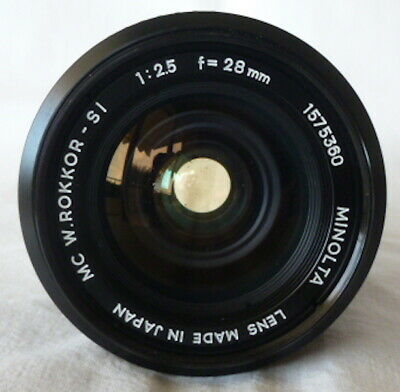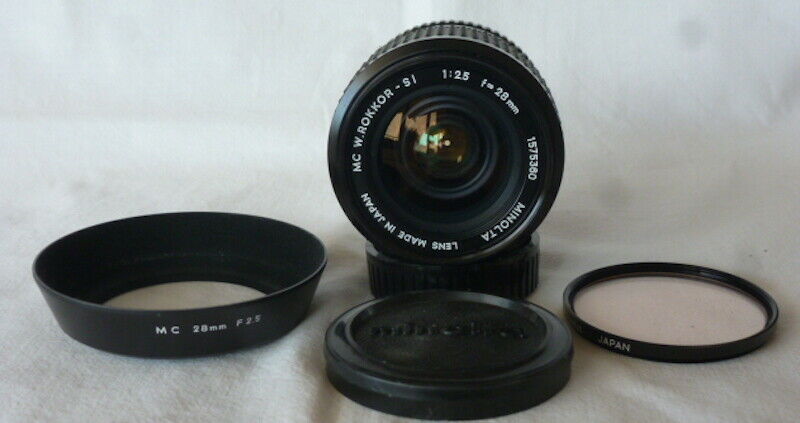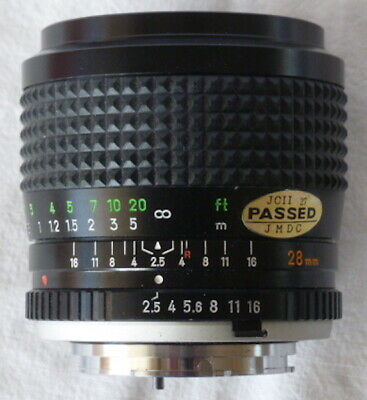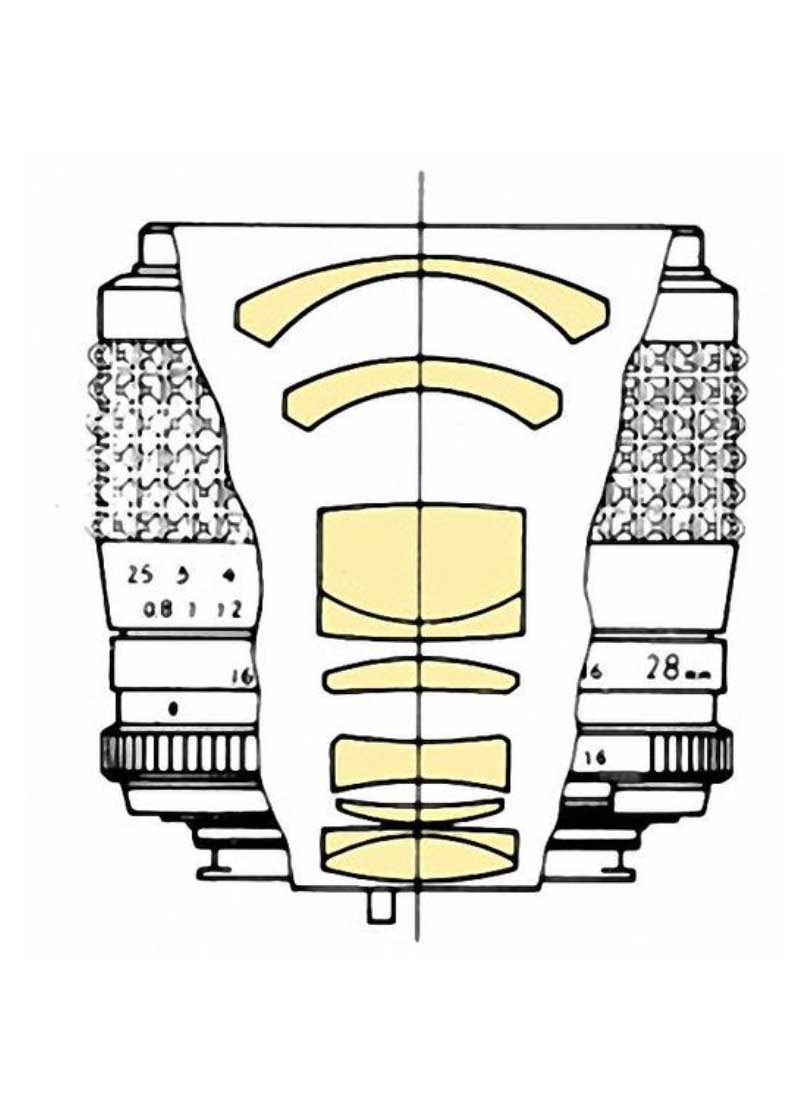This Lens
A very popular lens which is often mentioned in recommendations for someone who is looking for a wide-angle tool.
The lens has three reincarnations – MC I, MC II, and MC III. All released lenses with parameters 28mm F2.5 by Minolta are radioactive and this often causes yellowing which is cleared with a UV lamp. Minolta produced two lenses for 35mm cameras which contain active elements in the glass – this 28/2.5 and 58/1.2 (reviewed on this site in non-radioactive version).
The 28/2.5 hasn’t any non-radioactive versions but from my point of view the level of activity is low and if to follow simple rules everything will be fine. I recommend that you google more about radioactivity if you are worried. It seems to me that this trait adds a few points onto the popularity of this lens – it makes it a little unique and dangerous, so, only real rebels and cool guys use it.
There are actually a significant number of lenses produced from the 1940s through the 1970s that are measurably radioactive. You can check if a lens is radioactive with a geigercounter but as I don't have one I use a more simple method. Looking through the lens at a white sheet of paper reveals the elements’ yellowing compared to the surrounding white paper. A significant difference in tone indicates a higher chance that the lens is radioactive. On the other hand, clear glass does not mean that the lens does not contain radioactive materials – it can go both ways. As stated radioactive lenses lose their yellow tint when exposed to UV light.
The main source of radioactivity is the use of thorium oxide (up to 30% by weight) as a component of the glass used in the lens elements. Thorium oxide has a crystalline structural similar to calcium fluoride (fluorite). Like fluorite, its optical properties of high refractivity and low dispersion allows lens designers to minimise chromatic aberration and use lenses of lower curvature, which are less expensive to produce but much more than this. A high index of refraction means light travels slower within the glass, and therefore, changes its direction more easily. Lenses can have a lower profile, require less material and thus be lighter.
The addition of thorium oxide, or thoria, to the glass increases refractive index while maintaining low dispersion. Low dispersion, defined by Abbe number, allows lenses to correct chromatic aberration, ensuring the same focus is maintained throughout the whole range of colours in the visible spectrum, creating sharper images.
Combining these properties enables lenses with the excellent optical performance so these properties are especially beneficial for making optical glass. As a result manufacturers mostly used thoriated glass for the fastest, more expensive lenses, such as the f1.2s and f1.4s, but slower radioactive lenses also exist.
Eventually, by early 1980s, the thoriated glass fell out of use for consumer lenses – due to the factory workers’ health concerns and consumer radiophobia following nuclear accidents.
Despite statements to the contrary, lenses containing lanthanum are not appreciably radioactive - lanthanum is only 1/10,000th as radioactive as thorium.
We are regularly exposed to radiation from various sources every day, which combined give a more significant dose than the use of any radioactive lenses:
- Walking around outside in the sun (main contribution to the annual radiation dose)
- Staying at home (Radon from the building materials, tiles)
- Eating bananas (Contains potassium-40)
- Eating brazil nuts (Contains Radium-226)
- Flying on an aeroplane (about 2μSv/h of Cosmic radiation)
- Getting an x-ray at the doctor
- Sleeping next to someone (the other person is radioactive to us (potassium-40)
- Having a smoke detector (contains americium-241)
- Having a granite countertop (uranium and decay products)
- Smoking (releases radium, lead-210, polonium-210)
Radioactivity in lanthanum containing lenses is due to the intentional inclusion of thorium in the optical glass mix. The presence of thorium can sometimes, depending on the mixture of other elements in the lens, cause moderate to severe browning of the lens elements.
Some lenses, such as the early Minolta Rokkor lenses like this one, have elements to made of glass formulas which include small traces of radioactive rare-earth elements. Sometimes this incidental radioactivity causes a significant yellowing of these lens elements.
About yellowing of tested copyThe reviewed copy has the visible yellow-tint on the lens – this is a result of radioactive decay. The colour can be easily fixed with an ultraviolet lamp (or you can give the lens a sun-bath if you do not have a UK lamp) but some folks may want to leave it as a creative addition or because it is both easy to fix in software, and keeping this tint untouched turns the lens into good example which demonstrates the radioactive decay effect on rare earth glass. I like the warm colour cast in my photos, so leave the lenses as they are – it is, after all, a unique “feature” of a thoriated lens.
Lens In UseThe lens has low aberrations and nicely fixed geometric distortion. This lens also has a pleasant rendering that may be successfully used for a herbs/flower photography or subject photography, etc.
The lens is really sharp and provides enough good resolution over the frame from F5.6 (F8.0 is better of course) – an amazing result for wide lenses.
This lens came in three versions:
MC-I version from 1969 - 1970
MC-II version from 1970 - 1973
MC-X version from 1973 - 1975, with rubber focus ring
All three versions have an identical lens design with one radioactive Thorium glass
.
The lens tested here is MC-X version from 1973 - 1975, with rubber focus ring
Format: 35mm SLR
Type: Prime lens
Focusing: Manual Focus (MF)
Lens mounts: Minolta SR (MD, MC)
First year of production: 1969
Last year of production: 1975
Optical design: 9 elements in 7 groups (at least one high-refraction thorium glass)
Summary
Great fun with this lens embracing the imperfections. The unique rendering created as a direct result of the radioactive glass is something I believe you are challenged to contend with differently than you would any normal lens.
For general information on lens design and lens elements go to the homepage
HERE







